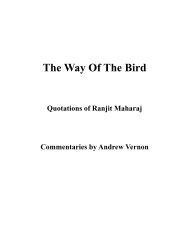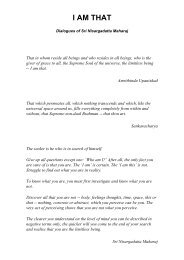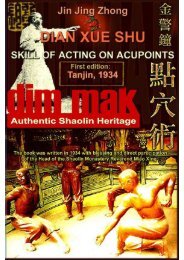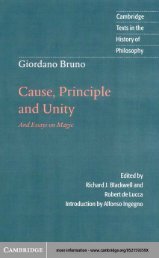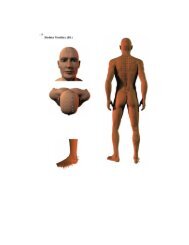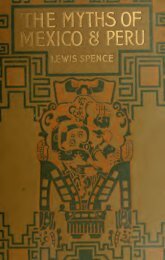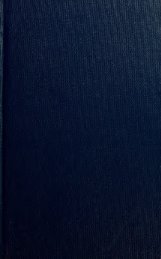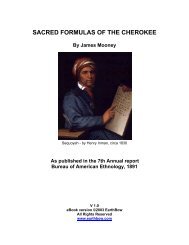You also want an ePaper? Increase the reach of your titles
YUMPU automatically turns print PDFs into web optimized ePapers that Google loves.
hun is often translated) during this time.<br />
Different from po (see the chapter on lung for more information), the vital instinctive spirit<br />
that is tied closely to the material body, hun is what is believed to leave the body after death and<br />
what can be called upon in prayers. The wandering ghosts (that usually cause trouble) described in<br />
Chinese stories are actually hun that roam about aimlessly, because they have nobody to perform<br />
the pacifying sacrificial rites for them.<br />
According to traditional concepts, male physiology is mostly based on qi (yang), while female<br />
physiology is primarily based on blood (yin). Males tend to have an abundance of qi that they can<br />
afford to spend freely, while females have an abundance of blood that they can give away freely (as<br />
becomes evident from the menstrual bleeding). Liver function, therefore, has great influence over<br />
an important part of female physiology-menstruation.<br />
The penetrating vessel and the conception vessel, are two pathways linked to the liver that are<br />
intimately involved with the transportation of blood. The penetrating vessel, above compared to a<br />
warehouse, is also called the Sea of Blood; and the conception vessel, as the name indicates, is<br />
credited with the function of nourishing the uterus and the fetus. Both the conception vessel and the<br />
penetrating vessel belong to the category of the eight extraordinary vessels. Both these vessels are<br />
involved in the liver's ability to store blood; they set out from the uterus, and are also closely linked<br />
with the kidney channel.<br />
The Neijing says: "In females, the tiangui (ability to conceive) arrives at the age of two times<br />
seven; at this point, the conception vessel will be open, the penetrating vessel will be exuberant,<br />
and therefore menstruation arrives in regular intervals and pregnancy becomes possible....At the<br />
age of seven times seven, the conception vessel becomes deficient, the penetrating vessel is<br />
exhausted, the tiangui dries up, and menstruation stops; aging is taking place and there will be no<br />
more pregnancies."<br />
The tendons connect the muscles to the bones. In accordance with the characteristics of the liver,<br />
they facilitate smooth and continuous movement. Because of this basic concept, some scholars<br />
have recently included the nerves (which do not have a separate designation in classical Chinese<br />
theory) under the category "tendons" (jin). The proper functioning of the tendons relies entirely on<br />
their nourishment by liver blood.<br />
The nails are considered the surplus of the tendons: as such, they are an exterior manifestation<br />
of the general quality of the tendons, and thus, liver blood within. Dry and brittle or extremely pale<br />
nail beds always indicate a poor quality of liver blood, while pink nailbeds and firm nails indicate a<br />
healthy state of liver blood.<br />
Hair is also associated with the liver blood: it is called the "surplus of the blood" (xue yu). The<br />
rich liver blood of females is expressed in lush, long, and fast growing hair on the head; males have<br />
more facial and body hair, which is governed by the qi organ, lung. Dry and brittle hair can be an<br />
indication of liver blood deficiency, while hair that suddenly falls out (alopecia) is usually because<br />
of both deficiency of blood and impeded flow of liver blood to the head, usually due to sudden<br />
emotional trauma.<br />
The eyes are nourished by the essence of all five organ networks, and thus differentiated into five<br />
organ specific zones which may reveal important diagnostic information. The eyes as a whole,<br />
however, represent the opening of the liver, and are thus considered to be more closely linked to<br />
the liver than to any of the other organ networks. "Liver qi communicates with the eyes," states the<br />
Neijing, "and if the liver functions harmoniously, the eyes can differentiate the five essential<br />
colors....If the liver receives blood, we can see. The liver channel branches out to the eyes. Both<br />
liver qi and liver blood flood the eyes to maintain proper eyesight. A person's eyesight may<br />
therefore also serve as an indicator for liver function.







